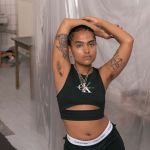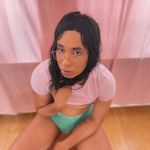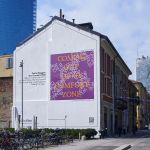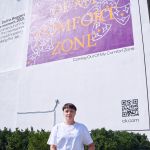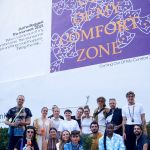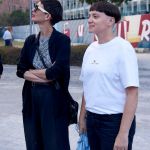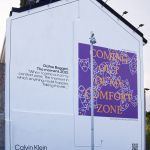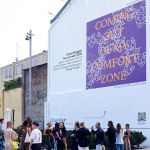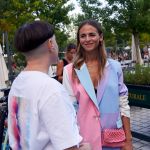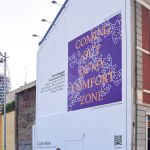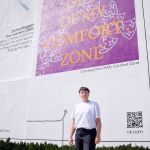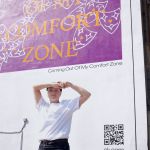
Calvin Klein e Dafne Boggeri present the project "Coming out of my Comfort Zone"
The work of art created by the artist in Milan is part of the project #proudinmycalvins
September 10th, 2021
Calvin Klein once again confirms its support for the LGBTQIA+ community, inviting four queer artists to tell the most significant moments of their journey through the creation of murals. The artists, called by the brand to express their creativity through this form of street art, presented their works in collaboration with the Institute of Digital Fashion (IoDF) in different cities in Europe, turning the streets into open-air museums.
The four protagonists are Sarah Naqvi, who created and presented Etymologies of Erasure in Amsterdam in July; Danielle Brathwaite-Shirley, author of There is Power not Passing in Berlin, a work about the black trans experience; Tanaka Fuego, who used her mural Ancestor Encore mural in London as a platform to show pride for her origins. Last but not least, on September 8th in Milan it was the turn of Dafne Boggeri, who presented the project Coming out of my Comfort Zone. Multidisciplinary artist, curator of an independent publishing house and founder of the female and non-binary collective @tomboysdontcry, Dafne chose to represent with her mural a tribute to the LGBTQAIXYZ movements of the 70s, through the choice of colors and the use of masks from the Greek mythology.
"I am particularly interested in the idea of modifying, concealing or transforming our connotations, and these masks, so full of meaning, are part of a research that I have been carrying out for years on their representation, use and diffusion in different cultures but also used in a universal way to express joy and pain, in their most concrete aspect and in a broader sublimation." - says Dafne.
On the occasion of the presentation of the project, Dafne Boggeri told nss G-Club, through an interview, all the curiosities about her work and the collaboration with Calvin Klein.
CHi Dafne, can you tell us something about yourself and your project @tomboysdontcry. When did the collective come to life and what are the main activities you deal with?
TOMBOYS DON'T CRY was born in 2011 together with S/HE (Mark Rebel) as a project linked to the perimeter of the club, be it real or metaphorical, to welcome precious beasts, lesbians on ecstasy, wonder queers, absolute beginners, girls interrupted and all the creatures that recognize themselves in the interstices of these imaginaries. Our practice is post-identity, developed within Pornflakes Crew, the first Italian queer collective founded in the '00s in Milan. That incredible experience, of playful endurance and tactical frivolity, set in motion to create alliances between bodies and genuinely get out of the box through non-commercial research, taught us a lot and then pushed us to evolve in this new adventure aimed above all at girls of any gender and non-binary creatures. Over the years we have met fundamental people with whom to share projects, the filmmaker Alice Daneluzzo, the artist / performer Petra Rocca and the photographer Ilenia Arosio. We started to self-produce an apparel hacking line, which we consider as an underlying way for people to recognize each other and maybe start new conversations; we continued to play as DJs, to promote evenings by taking care of every aspect of the organization, in an environment that is often not very inclusive; we curate BODY LANGUAGE queer transfeminist image review and participate in more or less institutional exhibition projects.
Coming out of my Comfort Zone combines street art with Greek symbolism and mythology, in addition to the reference to the LGBTQAIXYZ movements of the 70s. How do these elements communicate with each other in your work?
The work is made up of two elements: the text, which is a mantra that I often repeat to myself, and a pattern of stylized masks, reminiscent of the Greek mythological figures of Thalia and Melpomene, the muse of comedy and that of the tragedy. Through the title Coming Out of my Comfort Zone I wanted to bring out that part of 'potential' we all have, in our own way, but which sometimes remains latent. We can identify 'comfort' as a series of more or less rooted and characterizing habits, which can risk suffocating us. Their positive connotation can also turn into a sort of addictive attitude or lack of empathy and desire to confront the dimension of discovery and the unexpected, through which we can instead expand our knowledge. Celebrating a new way of approaching the things we know, embracing the unknown.
In addition to this 'cosmic' meaning, there is also a relationship with the 'local' and the neighborhood where the piece is placed: Porta Nuova is an area of accelerated gentrification, full of contradictions and a strange and widespread narrative that accompanies its evolution which does not always correspond to the reality of the facts - often more problematic than they seem - and which should be the lever of a broader and more careful debate on how to live and redesign public and private spaces in Milan in a more inclusive and intersectional way.
Your creative piece is part of a global campaign by Calvin Klein, #proudinmycalvins, dedicated to the theme of Pride and supporting the LGBTQIA+ community: what does it mean for you to be part of this project?
It probably meant 'getting out of my comfort zone', getting involved with to a role that I believe no one ever feels sufficiently prepared to get, especially with this type of visibility, compared to a community that is so large, varied and vibrant, whose boundaries fade or change in a free and changing movement and at times their presence can be felt only by being very careful to perceive their frequencies.
I am also happy that the inauguration of the mural did not take place in June, the Pride Month, and that we can find space and time to bring out the pride of belonging to the queer community even at different times of the year, not only in such a symbolic month as that of June. What can be said in support of a struggle in which I am immersed, always claimed, fought by those who before me and who will come? I thought that an umbrella message, such as the word 'queer', which embraced different types of attitude and encouraged any form of change, and attention, was ideal. Whispered to those who, while walking, raise their eyes to the sky and shouted to the 'ghost' neighborhood, which brings with it a corporate world and privileges.
What does it mean to be a multidisciplinary artist and what are your main means of artistic expression?
I have always dedicated myself to different expressive languages. The first was perhaps the editorial one, with funny zines made without knowing how to read or write, then I painted illegally for ten years, mainly spray trains in the context of the Italian Hip-Hop scene - in a dimension in which the concept of appropriation was vital for both subjects: in order to feel alive, in the Italian provinces, we reworked the codes that came to us from the Latin and Afro-American scene, mainly from New York and the Hip-Hop culture itself which, in America, it was rapidly transforming, in danger of disappearing. This period of strong experimentation also helped me to get closer to the idea of performance, but in general, being a queer person from birth has always led me to consider multiple points of view of the same reality and its hierarchies (more or less artificial ), in which spaces, objects, emotions and stories can be observed from different angles, to be then overturned and transformed into new perceptions.
Whether I work with gesture, sound or image, there is a constant sense of 'other' in my work, which often results in the 'invitation' as an artistic practice itself. For example, this is the case for SPRINT, the independent publishing and artist exhibition that I have been creating since 2013 together with Sara Serighelli of the non-profit association O 'and which this year will take place from November 26th to 28th in collaboration with the Swiss Institute, at Spazio Maiocchi, with many collaborations and special projects between Italian and foreign publishing realities.
How has the project @tomboysdontcry evolved from its beginning to today? And how is Milan evolving, in your opinion, in terms of support and inclusion of the queer/LGBTQIA+ community?
If TOMBOYS DON'T CRY were a material it would be spandex, its attitude is extremely elastic. We started with an activity that mainly involved clubs, or the run-down spaces that we transformed into dance halls, but today, especially respecting the current health situation, we are dedicating ourselves more and more to collaborations related to visual and performance art and not only to the creation of nightlife adventures. Even if it is not always easy to find companies willing to invest space, time and resources in projects and in general in formats as uninstitutional as ours. This is why allies are essential, to help and support each other in the very fragile Italian landscape for artistic production and survival.
In Italy, and specifically in Milan, I believe that the situation - queer support/inclusion - is complex. The 'layer' of tolerance accelerated by the internet and social media, like the fashion system which has always been the most inclusive industry - albeit with contradictions - give encouraging signs, but the urgencies are many and need to be translated into concrete actions. It is not enough to officially identify the Porta Venezia district as 'gay friendly' to solve the problems of intolerance and the difficulties that can arise within such an articulated community, even with regard to welcoming immigrants from territories where they are persecuted or, from an intersectional point of view, with respect to the possibility of having an abortion in a public hospital, given the number of conscientious objectors in Italy. I don't know how symbolic it is that right in front of the mural once stood the gay BDSM club 'La Nuova Idea' which was razed to the ground to create a privately run public space whose main message is: decorum.




















.webp)




.webp)















































